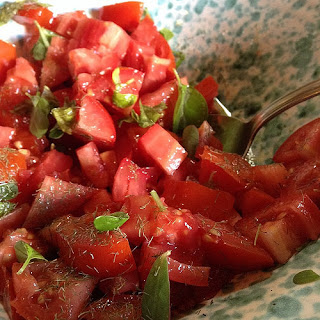from
Behind the French Menu
by
Bryan G. Newman
behindthefrenchmenu@gmail.com
Chamoiswww.flickr.com/photos/23074701@N02/36003110583/
The chamois on French menus is often
translated as a mountain antelope; nevertheless, it is in fact, a mountain
goat, and a very tasty goat at that. The chamois in the Alps, the izard or
isard in the Pyrenees and its cousins elsewhere in France are wild; they have
never been farmed. Fully grown the Alpine Chamois reaches 80cms high and have
20 cm horns; they are all legally hunted in season
The Chamois of the Alps and the Isard or
Izard of the Pyrenees are the most well-known. In addition, two other chamois
family group live in the southeast of France:
The Vercors Chamois that lives in the
Vercors Massif.
The Chartreuse Chamois that lives in the
Chartreuse Massif.
Outside of France, there are family
members in nearly all the countries of Europe through to the Caucasus.
The Chamois and the
French kitchen.
The meat from adult chamois needs to be
well marinated before they are cooked and so the most popular dish prepared for
a mature chamois is a civet,
a stew. Steaks and roasts come from
young animals, and in the hunting season, the liver of young mountain goats
will be on restaurant menus though it is a costly delicacy. In Southern France cow's milk was rarely part
of the menu or the local's diet before the 1930's; goats and sheep were raised
for their milk and cheeses. The young
males produced no milk, and so Southern France developed many tens of excellent
recipes for sheep and goat and so the goat recipes were long ago adapted for
the Chamois.
Chamois in the snow.
A stew of chamois served with red
cabbage. This one of the most popular
and traditional ways to serve mature animals from the hunt. Most recipes allow for twenty-four hours,
sometimes 48 hours, for the marinating which will be done with the aid of a
robust red wine. The cabbage will be added an hour before serving. These stews,
as may be expected, have a gamey aroma, but that will not be overbearing, and
for most diners it will be a rare opportunity to enjoy a memorable dish.
The Chamois on French menus:
Civet
de Chamois avec Chou
Rouge – A stew of chamois served with red
cabbage. This one of the most popular and traditional ways to serve
mature animals from the hunt. Most
recipes allow for twenty-four hours, sometimes 48 hours, for the marinating
which will be done with the aid of a robust red wine. The cabbage will be added
an hour before serving. These stews, as may be expected, have a gamey aroma,
but that will not be overbearing, and for most diners it will be a rare
opportunity to enjoy a memorable dish.
Le Civet de Chevreuil à l’Ancienne
A traditional Chamois
stew.
Filets d'Isard aux Mousserons – A fillet, tenderloin, from
a young isard, the Pyrenean chamois; served with wild St
George’s mushrooms.
Médaillons
de Chamois - Small steaks or slices of meat from a young
chamois. In the French kitchen,
médaillons indicate oval or round cuts.
La Selle d'Izard Garniture de Saison, le Jus aux Baies
de Sureau et au Cassis
- The saddle, the back
from the izard, the chamois, served with the vegetables of the season and
prepared with a sauce made with elderberries
and the European
blackcurrant. The saddle is a cut from the back with the whole saddle
including both sides, together with the loin chops. When a saddle of a young mountain goat is on
the menu it will more than a portion for one or two; the restaurant will offer
slices from this roast, and a cut from the saddle is one of the best cuts from
young game animals.
A herd of chamois
www.flickr.com/photos/94941635@N07/16973999769/
La Carte de Chasse -
the hunt menu.
When wild game is in season, many
restaurants will have a menu called the Carte de Chasse, a hunt menu. The
French term for the hunt, la chasse, is also used for sports fishing and the
word became the chase in English. In certain areas, some restaurants
only open during the hunting season.
Hunting and
photographing the Chamois.
For those who wish to go hunting or
photographing, you need to be in excellent health as the only way to catch or
closely observe these animals is by stalking. That means following them by foot
in the upper reaches of the mountain ranges. The Chamois find their
homes in the mountains and depending on the time of year that can reach up to
2,300 meters (7,500 feet) and even 3,000 meters (9,900 feet) in the Alps
and the Pyrenees.
Chamois
www.flickr.com/photos/muriel_vd/1019975485/
The Alpine Chamois in the languages of
France’s neighbors:
(Catalan – isard), (Dutch - alpengems),
(German - gämsen), (Italian - camoscio
alpino), (Spanish - rebeco, gamuza, sarrio), (Latin - rupicapra rupicapra)
Isard, Izard or Pyrenean Chamois in the languages
of France’s neighbors:
(Catalan: isard pirinenc),(Dutch -
Pyrenese gems),(German Pyrenäen-Gämse) (Italian: camoscio, camoscio pirenaico,
camoscio dei Pirenei), (Spanish - ebeco pirenaico, sarrio), (Latin - rupicapra
pyrenaica)
The Chartreuse Chamois in the languages
of France’s neighbors:
(Dutch
- chartreusegems), (German -
chartreuse-gämse ), (Italian - camurça da França), (Spanish -
este de Francia )
--------------------------------
Behind the French Menu
by
Bryan G. Newman
behindthefrenchmenu@gmail.com
Copyright 2010,
2013, 2016, 2019
--------------------------------
Searching for the
meaning of words, names or phrases
on
French menus?
you are searching for to the words
"Behind the French Menu" (best when including the inverted commas),
and search with Google, Bing, or another browser. Behind the French
Menu’s links, include hundreds of words, names, and phrases that are seen on
French menus. There are over 450 articles that include over 4,000 French dishes
with English translations and explanations.
Connected Posts:













